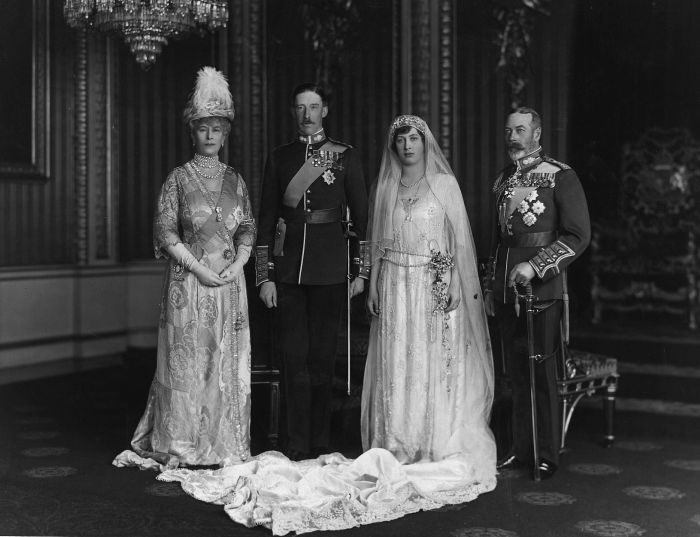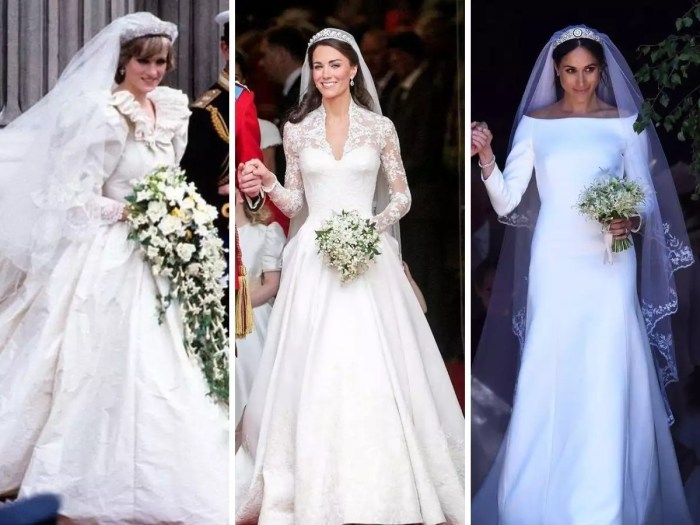A Regal History: English Royal Wedding Dresses
English royal wedding dresses – From the opulent Victorian era to the modern day, English royal weddings have captivated the world with their grandeur and the stunning gowns worn by the brides. These dresses are more than just clothing; they are powerful symbols of tradition, evolving fashion, and national identity, reflecting the tastes and social climate of their time. This exploration delves into the rich history of these iconic garments, examining their design elements, the roles of influential designers, and their enduring legacy.
Historical Overview of Royal Wedding Dresses, English royal wedding dresses
A chronological examination of significant English royal weddings reveals a fascinating evolution in bridal fashion. The choice of fabric, silhouette, and embellishments often reflected prevailing styles and cultural values.
| Wedding Date | Bride | Designer | Key Features |
|---|---|---|---|
| 1840 | Queen Victoria | Unknown (likely a collaboration of court dressmakers) | Honiton lace, satin, orange blossoms, a high neckline, and a long train. |
| 1863 | Princess Alexandra of Denmark | Unknown | Embroidered satin, featuring a high neckline and long sleeves, reflecting Victorian styles. |
| 1910 | Queen Mary | Unknown | Elaborate embroidery, featuring silver and pearls, a high neckline, and a full skirt, characteristic of the Edwardian era. |
| 1947 | Queen Elizabeth II | Norman Hartnell | Ivory satin, featuring intricate embroidery with flowers and seed pearls, reflecting post-war austerity and optimism. |
| 1981 | Diana, Princess of Wales | David and Elizabeth Emanuel | Taffeta, antique lace, 25-foot train, puff sleeves, and a high neckline. |
| 2011 | Catherine, Duchess of Cambridge | Sarah Burton for Alexander McQueen | Satin, lace sleeves, a fitted bodice, and a long train, a modern take on classic bridal styles. |
The Victorian era favored high necklines, long sleeves, and full skirts, reflecting a more conservative aesthetic. The Edwardian period saw a shift towards a more streamlined silhouette, with simpler embellishments. Modern royal wedding dresses often blend traditional elements with contemporary designs, reflecting a balance between tradition and innovation.
The symbolism of fabrics and embellishments is profound. Lace, for instance, often represents purity and elegance, while the choice of satin speaks to luxury and sophistication. Embroidery frequently incorporates national flowers or motifs, adding a layer of cultural significance.
Design Elements and Trends
Several design elements have consistently appeared in English royal wedding dresses, demonstrating a continuity of aesthetic preferences.
English royal wedding dresses are renowned for their grandeur and tradition, often featuring intricate lace and opulent fabrics. However, a more modern approach is seen in the increasing popularity of less formal ceremonies, where the focus shifts to personal style. For a simpler yet stylish celebration, consider options like those showcased on websites such as courthouse wedding dress not white , which offer a refreshing alternative.
Ultimately, the choice reflects the couple’s individual preferences, whether it’s a regal affair or a more intimate gathering.
- Lace: A recurring motif signifying purity and refinement.
- Embroidery: Often incorporating national flowers or symbolic designs.
- Train Length: A key indicator of status and formality, varying from modest to exceptionally long.
- Silhouettes: From the full skirts of the Victorian era to the more fitted styles of the modern day.
Comparing the design choices of different royal brides reveals individual preferences and stylistic influences. Queen Victoria’s dress was a relatively simple, yet elegant, reflection of her personal taste, while Princess Diana’s gown was a dramatic statement reflecting the fashion of the 1980s. Kate Middleton’s dress showcased a modern sensibility with classic undertones.
Societal trends and fashion have profoundly influenced royal wedding gown designs.
- Post-war austerity (1947): Queen Elizabeth II’s dress, made with ration coupons, reflected the economic realities of the time.
- 1980s romanticism (1981): Princess Diana’s voluminous gown embodied the romantic styles of the decade.
- Modern minimalism (2011): Kate Middleton’s elegant, understated gown represented a contemporary aesthetic.
The Role of Designers
Several prominent designers have shaped the aesthetic of English royal wedding dresses. Their biographies and design philosophies reveal a fascinating interplay of creative vision and royal expectations.
Norman Hartnell, designer of Queen Elizabeth II’s gown, was known for his elegant and refined designs, often incorporating intricate embroidery and luxurious fabrics. David and Elizabeth Emanuel, who created Princess Diana’s iconic dress, were celebrated for their innovative and romantic style. Sarah Burton, who designed Kate Middleton’s dress, is renowned for her ability to blend classic and contemporary elements.
The design process for a royal wedding gown involves extensive collaboration between the bride, designer, and a team of skilled artisans. The designer works closely with the bride to understand her vision, taking into account her personality, the wedding setting, and the historical context. The process often involves numerous fittings and revisions, ensuring a perfect fit and a flawless final product.
A comparison of the design philosophies reveals distinct approaches. Hartnell’s designs were characterized by classic elegance and intricate detail, while the Emanuels embraced a more romantic and dramatic style. Burton’s work demonstrates a modern sensibility with a respect for tradition.
The Impact and Legacy

Source: thoughtco.com
Iconic royal wedding dresses have had a lasting influence on fashion and popular culture. They inspire designers, set trends, and are frequently referenced in media and popular imagination.
Royal weddings generate significant economic activity within the fashion industry, boosting sales of bridal wear and related products. The global media attention surrounding these events translates into immense marketing opportunities for designers and brands associated with the event.
Royal wedding dresses shape public perception and understanding of royal style and tradition. They communicate messages about the monarchy’s image and its connection to the nation.
The enduring legacy of English royal wedding dresses lies in their ability to transcend mere fashion and become powerful symbols of national identity, reflecting evolving social values and artistic sensibilities. They are a testament to the enduring power of tradition, innovation, and the enduring fascination with royal romance.
Visual Representations

Source: toiimg.com
Queen Victoria’s wedding dress, worn in 1840, was made of Honiton lace, a delicate hand-made lace from Devon, England, over a white satin base. The high neckline and long sleeves were typical of Victorian fashion, reflecting the era’s conservative sensibilities. The dress featured orange blossoms, symbolizing fertility and purity, and a long train, signifying her status. The historical context underscores the importance of promoting British craftsmanship and upholding traditional values.
Princess Diana’s wedding dress, worn in 1981, was a dramatic and voluminous creation of ivory silk taffeta and antique lace. Its puff sleeves, high neckline, and exceptionally long train (25 feet) were a stark departure from previous royal wedding gowns, reflecting the romantic and extravagant fashion of the 1980s. The sheer scale of the gown, paired with its intricate details, captured global attention and set a new standard for royal bridal fashion.
This gown, designed by David and Elizabeth Emanuel, became an instant icon, shaping bridal trends for decades to come.
Kate Middleton’s wedding dress, designed by Sarah Burton for Alexander McQueen in 2011, was a more understated yet elegant design. Made of ivory satin gazar, it featured long, lace sleeves, a fitted bodice, and a long train. The lace, hand-made by the Royal School of Needlework, incorporated traditional motifs, paying homage to royal wedding gown traditions while maintaining a contemporary, sophisticated aesthetic.
The designer’s inspiration drew from classic bridal styles, creating a gown that felt both timeless and modern, reflecting the Duchess’s own refined and elegant style. The dress’s simplicity and classic design have made it a lasting symbol of modern royal style.
Commonly Asked Questions: English Royal Wedding Dresses
What is the average cost of a royal wedding dress?
The cost varies greatly depending on the designer, fabrics, and embellishments. Precise figures are rarely publicly released, but it is safe to assume they are extremely expensive, reaching into the hundreds of thousands, or even millions, of pounds.
Who typically pays for the royal wedding dress?
Traditionally, the bride’s family bears the cost of the wedding dress. However, the specifics can vary depending on the circumstances and the family’s financial arrangements.
Are royal wedding dresses always white?
While white has become the dominant color in recent centuries, historically, royal brides wore a variety of colors. Queen Victoria’s choice of white started the trend towards white wedding dresses.
What happens to the royal wedding dresses after the wedding?
They are often preserved and sometimes go on display in museums or royal collections. Their future is usually determined by the royal family.
